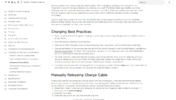2012 P85 RWD here - pic is from Tesla MS Owner's Manual under "Charging Best Practices". I thought we were supposed to obey the 20/80 rule?



Last edited:
You can install our site as a web app on your iOS device by utilizing the Add to Home Screen feature in Safari. Please see this thread for more details on this.
Note: This feature may not be available in some browsers.

I've been driving a Tesla since 2012 or the past 13 years, and I've never seen the manual mention the 20/80 charging rule....20/80 rule?



Great info, thanks. You're right, the owner's manual probably never mentioned the 20/80 rule. That 20/80 rule seems to be what the rest of the world recommends on YouTube, articles, etc.I've been driving a Tesla since 2012 or the past 13 years, and I've never seen the manual mention the 20/80 charging rule.
I've been sticking to the manual instructions: plugin, 90%, and my results have not been bad:
When I sold my 2012 Tesla Model S at 100,000 miles in 2018, its 100% charge was 252.54 miles or a loss of 12.46 miles (out of 265 maximum miles) or a loss of 4.7%:

When I sold my 2018 Tesla Model 3 at almost 50,000 miles, its 100% charge was 285.81 miles or a loss of 24.19 miles out of 310 maximum miles or 7.80%.

Here's my current 2017 Tesla Model X report: its 100% expected range was 268 miles or a loss of 27 miles out of 295 maximum miles or 9.15%.

Ive only seen this on the new LFP batteries. Could be an owners manual typo? Tesla HAS changed things a number of times in the last 11 years for the Model S.2012 P85 RWD here - pic is from Tesla MS Owner's Manual under "Charging Best Practices". I thought we were supposed to obey the 20/80 rule?

View attachment 933799
2012 P85 RWD here - pic is from Tesla MS Owner's Manual under "Charging Best Practices". I thought we were supposed to obey the 20/80 rule?
View attachment 933799
Great info, thanks. You're right, the owner's manual probably never mentioned the 20/80 rule. That 20/80 rule seems to be what the rest of the world recommends on YouTube, articles, etc.
Personally, the 20/80 rule is not good. I don't support it, and my ~400,000 miles of Tesla ownership/driving backs my opinion.
Charge to 100% regularly. While the cars will balance out the pack at lower SOC's, it does a much more thorough job at 100%, especially noted by the LONG time it takes to get that last few % in to the pack.
100% is NOT BAD FOR THE BATTERY! Charging to 100% and LEAVING IT AT 100% FOR LONG PERIODS OF TIME is BAD for the battery(Lithium Ion, LFP is just fine at 100%). Though, even that, is negligible. I have a video coming, where I took 2, 2015 P85 cells compliments of WK057. Left one at 100% for 7 years, and 1 at shutdown voltage for 7 years, to see the effects. The results will surprise everyone ;-)
Also based on my observations pertaining to battery failures, it honestly seems the people who have babied their batteries, are the ones having more issues. The people who use and abuse it and throw caution to the wind, have only a tiny bit more degradation, but overall life span of the battery before a replacement event is required appears to be exponentially higher.
My 75D MX has one cell out in one brick of the entire pack. If left at a lower SOC, the imbalance goes about 40-60mV. Only way to bring it back to balance, or I should say, it only ever balances out when charging to 100%. Takes absolutely forever.All it takes is a bad cell or two out of 7100 + to trigger the BMS and eventually brick the pack.
In 4 years and 40k miles, never seen any balance or capacity and esp range improvement going over 93% on a 85 pack. Minor improvement going over 77%.
Look forward to your test results, however.
Unless I'm going crazy, here's screenshot from link I posted.That screenshot is definitely something thats in the Model 3 Online manual, and the reference to RWD is clearly about the LFP battery. I could not find it (that screenshot text) in the linked model S manual.
Its already been covered that there is no "80/20" rule that has been put forth by tesla for any Tesla, though. Thats online forums stuff.

You are not going crazy, yet.
Thanks for confirming my sanityYou are not going crazy, yet.
I can confirm that at the time of this post this is stated in the current online and PDF version of the MS 2012-2020 owners manual. PDF version is showing as 2023.12 North America.
Hmmmm..
I'm thinking someone screwed up when they updated the online manuals. The only hard reference otherwise is for the LFP battery in the RWD Model 3 thus far.
Hey islandbayy, I wanted to ask you if you ever got your car replaced/ bought back? Not sure why I can't send messages.I'm thinking someone screwed up when they updated the online manuals. The only hard reference otherwise is for the LFP battery in the RWD Model 3 thus far.
You're probably right. Thx.I'm thinking someone screwed up when they updated the online manuals. The only hard reference otherwise is for the LFP battery in the RWD Model 3 thus far.
Could be making a switch to LFP in MS & MX for non-performance vehicles. LION will have higher output for performance vehicles


